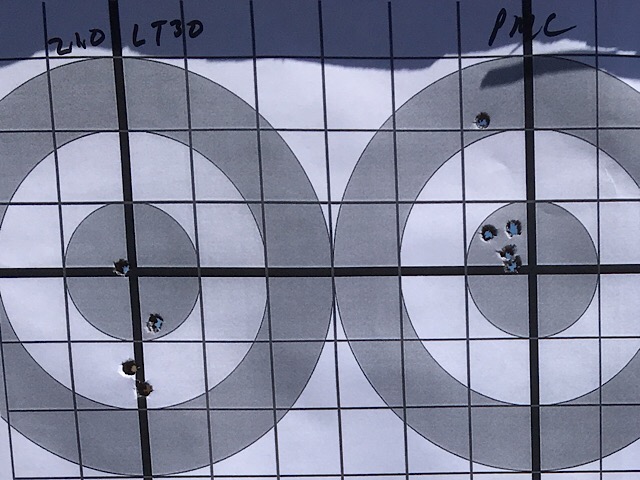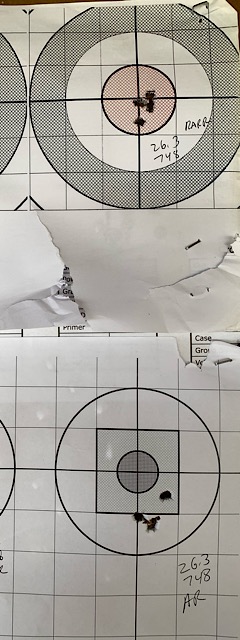Most of my shooting is with cast boolits but I just can't bring myself to cast those itty bitty boolits for my AR-15. I had purchased some time ago two bags of SS-109 steel core penetrators to load up and hope I never need.
There were pitfalls along the way. If you just want the results please scroll to the bottom. If you want to know how I got there, read on!
I searched the web at length looking for solid information on 748 and the SS-109 without finding much and some of what I found was fairly sketchy looking. I'm packing up my reloading room to move several hundred miles and kept some 748 out to load the SS-109s because I had excellent results with 748 and the 50 grain V-Max. I also had H335, BL-C (2), Varget and most of the usual powders but they were already packed. I have a lot of reloading manuals but of course none of them list the SS-109. Other bullets at or near the same weight had a very wide range of powder charges with 748; too wide to draw any solid conclusions.
- Hornady shows loads for 60-62 grain bullets of various designs and lists a starting charge of 22.1 grains at 2700 fps and a maximum charge of 25.5 grains with a velocity of 3100 fps. That just didn't look right based on my use of 748 and other bullets. No pressure was listed.
- Hodgdon shows a starting load of 22.3 grains at 2,779 fps and a max charge of 24.0 grains at 2,967 fps with a pressure of 52,400 PSI.
- My Sierra manual has their 63 grain SMP add 65 grain SBT bullets lumped together in their AR-15 specific pages. They call for a starting load of 24.3 grains for 2600 fps and a maximum charge of 25.9 and 2800 fps. No pressure data is provided.
- The Lyman #49 shows a 63 grain SMP and a starting load of 24.7 grains with a velocity of 2768 fps and a maximum charge of 27.5 grains at 3,142 fps. Pressure was listed at 49,300 CUP.
Now, none of these bullets are the SS-109 so all I can do is look at comparable weight bullets. The SS-109 is long for its weight due to the steel core. The load data for similar weight bullets varied widely as did velocity predictions. I don't think I have ever seen such a wide spread of recommendations and predictions for a narrow range of bullet weights. I was hoping to just load and go without doing load development but the Internet forum recipes varied as wildly as the reloading manuals so I gave in to doing some testing. I would ordinarily not take this approach to any handloading but I was up against time, cold temperatures and very windy conditions during my window of opportunity. The brass was sized, decapped and cleaned in a citric acid solution to remove the dark brown patina. It was then trimmed to length and the primer pockets were either swaged with a Dillon swage or reamed with a Hornady primer pocket reamer to remove the crimp, depending on my mood on the day a batch was processed. I bought 3,000 surplus Lake City military 5.56 cases and it took a while to process all of them. Case mouths were chamfered inside and out.
The first bag of SS-109s I loaded was based on starting charge information and I unfortunately loaded way too many (about 250 rounds) before deciding to do a ladder test. I just got more and more uncomfortable with the starting load as I researched further. The first bag of SS-109 bullets were at best, inconsistent in the point shape causing the OAL to vary about .015"-.020" so I had to adjust the seating die to keep everything under 2.260" OAL since these rounds would go in Ar-15 magazines. My target OAL was 2.258" just to make sure they would work in any magazine. For that reason I reduced my starting charge to 23.4 grains because of seating depth concerns. A second bag of SS-109s from a different source proved to not only look more consistent but proved to be much more consistent while loading with OALs varying about .005" from shortest to longest; a tolerance I found quite acceptable for SS-109s. These aren't competition target loads. They're crisis management loads. I don't consider myself a prepper but I lived in southeast Louisiana when Katrina hit so I'm going by the Boy Scout motto: "Be Prepared."
Utimately, I loaded up 5 rounds each of 5 powder charges using new SS-109s, Winchester Small Rifle Primers, Winchester 748 and the mixed Lake City surplus brass. All ladder test charges were thrown by an RCBS Chargemaster 1500 and loaded on a Rock Chucker II.
No attempt was made to check for accuracy due to the 20+ mph crosswind at the range. It was better than the 40+ gusting to 60 a couple of days earlier. My target behind the chronograph was a metallic silhouette pig at 200 yards and I had no trouble hitting it with any of the rounds. I just wanted to determine if all of the loads would function the rifle properly and if any exhibited signs of excessive pressure.
I noticed during the first string of 23.4 grain loads that I was getting a BAT notice on the chronograph. I had to wait for a cold range so I could change the battery but there was no data for that first string. It ended up not being very important. The rounds at 23.4 grains did cycled normally on a short gas system. After a battery change the chronograph worked as expected and the test went without further interruption.
Rifle used: AR-15, 16" barrel, 1:9 twist, 5.56 NATO chamber
Temperature was 65 degrees F, Humidity 18%, Elevation 3700'
Results:
Charge - ES - SD - Average - Comments
24.0 - 77 - 32 - 2542 Hornady predicted 2967 fps for this load
25.0 - 33 - 12 - 2677 Lyman predicted 2768 fps for 24.7 grains
26.0 - 35 - 15 - 2813
27.0 - 38 - 15 - 2908
Lyman predicted 3142 fps for 27.5 grains. I did not test 27.5 grains.
Conclusion: The data for commercially produced bullets in the 60-65 grain range was for the most part very conservative for the charge weights and excessively optimistic for the velocities. At 27.0 grains the primers were still rounded with no significant flattening. There is probably a slightly reduced radius but it would take an optical comparator to tell just how much. The corner of the primers is not even close to square at 27.0 grains.
I pulled all of the bullets for two batches of loads, using all of the first bag and a few of the second bag of bullets and recovered the powder. The bullets were pulled with an RCBS press mounted collet puller so they can be used again. The rounds will be reloaded with 27.0 grains of 748 and stored in a USGI ammo box which is air tight.

|
   
   
|


|







 Reply With Quote
Reply With Quote













 USAF RET 1971-95
USAF RET 1971-95




